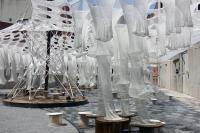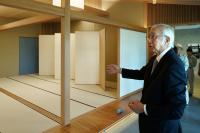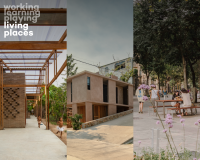CM House
Conegliano, Italy
When a house becomes a reference point for a family, it stops being an object frozen in time destined to inexorable degrade, and becomes instead a living and active organism that evolves to best respond to the needs of the family. The needs change and as consequence, so do the spaces; but it ever remains the starting and ending points of the whole family history.
The project consists in the renovation and extension of a two-family house, located in a protected area with environmental restrictions at the feet of the Conegliano castle. The natural context is admirable for both its views and terrain morphology.
The CM house is rooted first and foremost on the solid foundations of a united and compact family nucleus. The project’s logic takes its source in the will to preserve certain spaces, the careful analysis of the context and the aim to improve the accommodation capacity and inherent qualities of the building. The aim is to adapt an existing house to the needs of a family that is growing, without disorientating or losing sight of the needs of those whom inhabits the house since several decades. The essence of this graft process lies within the continual seek for balance between the different parts, between the old and the new. The latter seeks to reach its inherently right dimensions whilst avoiding to be too invasive towards the existing building and context. The quest revolves around the regeneration of a building without any intrinsic aesthetic qualities and no longer fit for nowadays living modes, to enable it to answer the needs of a growing family, adapting itself to the latter like a tailored piece of clothing.
The building is a stand-alone house, with two levels which form two distinct unities, inhabited by two branches of the same family. From an architectural perspective, the original building didn’t have any particular features. It reflects the frankness typical of beginning of the 60s Architecture: linear and symmetric facades completed by a simple level-divider, generous openings, a hip roof. The only variations to this prototype are a staircase leading to the second floor’s terrace, which connects to the Est façade at a 8° angle; and a small terrace on the west elevation obtained from a recess of the façade.
On the interior, the two plans are similar, even though they pursue different aims: the first floor is inhabited by the grandparents, whereas the ground floor accommodates the parents and children. It further contains a semi-cellar which was projected as a reception room with an annex kitchen and storage room.
Hence the project is born to answer real and immediate needs, namely more space for the second generation, which has quickly grown from two to five members; and the addition of a lift that connects the grandparents’ floor to the ground floor. The latter had to be a non-invasive operation to allow the grandparents to continue living in the house during the construction phase.
A further challenge was the limited possibility to expand the building outwards. Furthermore, the building needed to be structurally reinforced and the ground floor’s level lowered in order to achieve the minimal interior roof height set by regulations of 270 cm.
Hence the project consists in the graft of two new volumes to the existing one, filling and expanding towards the exterior the existing voids. The volume added to the west elevation contains the kitchen and the machine room for the lift. This also enabled to expand the terrace of the first floor apartment. The one added to the east façade, which fills the void underneath the staircase and the terrace, houses a new bathroom.
The new volumes stand out from the rest of the building thanks to the grid formed by big scale fibre concrete boards applied to the facade.
Internally, the lobby creates a hinge between the common spaces, like the living room, dining room and kitchen. These are interconnected by various doorless openings, whilst being delimitated by columns, furniture and level drops which create virtual thresholds between the different spaces.
















